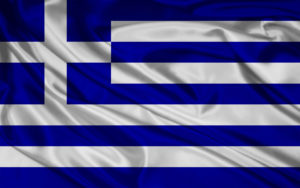
In “times gone by,” the toga wearing Greeks would mix a bit of tree resin and water with their wines. The reason for that mix was that the amphoras (ancient Greek bottles) were sealed with pine resin and some of the resin would mix with the wine. Apparently the Greeks became accustomed to the resins flavor and a style called retsina evolved. The thought of a modern wine drinker mixing a tree resin with their wine is abhorrent.
Today’s Greek wines are pure wine with nothing added unless the bottle is labeled retsina, which is still made for local consumption. What make the modern Grecian wines interesting is that they are often made from local grapes, We have to admit that we approached these wines with a bit of trepidation because we had never encountered them before and were completely amazed at how really good they were.
All of the Greek wines we tried were white and all were well made. If you are a true wine lover it is almost a demand that you try these wines to broaden your horizons and awareness of what is on the market besides the “same old thing from the same old place.”
Biblia Chora Estate Areti White ($23). If this is what Greek wines are like, lead us to them. This wine has the appearance of a Sauvignon Blanc but displays a deeper more interesting and inviting flavor and aroma. Made from local Assyrtiko grape, the color is a pale golden and displays the aromas lemon and grapefruit but none of the grass associated with Sauvignon Blanc. While the citrus carries over to the flavor it is balanced by an obvious sensation of almonds ending in a finish that is long and clean. The producer suggests that this is perfect for shell fish of all types but specifically points out oysters, clams, and mussels as well as any and all fish dishes. While comparison with Sauvignon Blanc is natural because of the color, this wine makes a more positive flavor and aroma statement and is most definitely enjoyable.
Gerovassiliou Estate Malagousia ($23). Malagousia is another local white wine grape that takes a different flavor and aroma direction from the Areti by presenting a host of fresh summer fruits. Pineapple, peach, and pear are the most obvious aromas while citrus comfortably resides in the background. It is citrus that is most obvious in the flavor but there is an interesting, pleasant and almost indefinable flavor that carries through to the finish. If you are the adventurous type, try this wine if you are not adventures try it anyway, its really a fine wine.
Ktimatselepos Manitina ($17). Another white from Greece but this time the vineyard was located on the Peloponnesus, the ancient home of the Spartans so you know this had better be good, and it is. Here too it is summer flowers and citrus that are the most obvious backed up by the ever-present citrus. These aromas follow through to the flavor and then on to the finish which is to say the least exceptional.
Just as a final note, these wine and any of the wines we write about are available in South Florida so if your wine vendor does not have them, ask him to get them for you. He can get single bottles from his distributor and it should be at the MSRP (manufactures suggested retail price). If he tries to get you to buy a case or ups the price … get another vendor.
 High Vacuum Engineer: Senior Technical Adviser and Feature Writer for Modern Photography Magazine (1967-1973), co-founder of Together Vineyards, an experimental vineyard in South Florida which was the southern most registered vineyard in the Continental United States. Co-Author of several books on Home Wine Making, Home Beer Making and Distillation of Spirits. Co-owner of Camera & Video Repair Institute in Sunrise Florida.
High Vacuum Engineer: Senior Technical Adviser and Feature Writer for Modern Photography Magazine (1967-1973), co-founder of Together Vineyards, an experimental vineyard in South Florida which was the southern most registered vineyard in the Continental United States. Co-Author of several books on Home Wine Making, Home Beer Making and Distillation of Spirits. Co-owner of Camera & Video Repair Institute in Sunrise Florida.